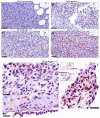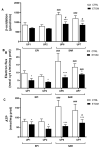Long-Chain Acyl Coenzyme A Dehydrogenase, a Key Player in Metabolic Rewiring/Invasiveness in Experimental Tumors and Human Mesothelioma Cell Lines
- PMID: 37297007
- PMCID: PMC10252348
- DOI: 10.3390/cancers15113044
Long-Chain Acyl Coenzyme A Dehydrogenase, a Key Player in Metabolic Rewiring/Invasiveness in Experimental Tumors and Human Mesothelioma Cell Lines
Abstract
Cross-species investigations of cancer invasiveness are a new approach that has already identified new biomarkers which are potentially useful for improving tumor diagnosis and prognosis in clinical medicine and veterinary science. In this study, we combined proteomic analysis of four experimental rat malignant mesothelioma (MM) tumors with analysis of ten patient-derived cell lines to identify common features associated with mitochondrial proteome rewiring. A comparison of significant abundance changes between invasive and non-invasive rat tumors gave a list of 433 proteins, including 26 proteins reported to be exclusively located in mitochondria. Next, we analyzed the differential expression of genes encoding the mitochondrial proteins of interest in five primary epithelioid and five primary sarcomatoid human MM cell lines; the most impressive increase was observed in the expression of the long-chain acyl coenzyme A dehydrogenase (ACADL). To evaluate the role of this enzyme in migration/invasiveness, two epithelioid and two sarcomatoid human MM cell lines derived from patients with the highest and lowest overall survival were studied. Interestingly, sarcomatoid vs. epithelioid cell lines were characterized by higher migration and fatty oxidation rates, in agreement with ACADL findings. These results suggest that evaluating mitochondrial proteins in MM specimens might identify tumors with higher invasiveness. Data are available via ProteomeXchange with the dataset identifier PXD042942.
Keywords: biomarker; fatty acid β-oxidation; long-chain specific acyl-CoA dehydrogenase; malignant mesothelioma; metabolism; mitochondria.
Conflict of interest statement
The authors declare no conflict of interest.
Figures






Similar articles
-
Hepatocellular carcinoma stage: an almost loss of fatty acid metabolism and gain of glucose metabolic pathways dysregulation.Med Oncol. 2022 Oct 8;39(12):247. doi: 10.1007/s12032-022-01839-0. Med Oncol. 2022. PMID: 36209296
-
Cross-Species Proteomics Identifies CAPG and SBP1 as Crucial Invasiveness Biomarkers in Rat and Human Malignant Mesothelioma.Cancers (Basel). 2020 Aug 27;12(9):2430. doi: 10.3390/cancers12092430. Cancers (Basel). 2020. PMID: 32867073 Free PMC article.
-
AHNAK is highly expressed and plays a key role in cell migration and invasion in mesothelioma.Int J Oncol. 2014 Feb;44(2):530-8. doi: 10.3892/ijo.2013.2183. Epub 2013 Nov 20. Int J Oncol. 2014. PMID: 24253341
-
Mitochondrial β-oxidation of saturated fatty acids in humans.Mitochondrion. 2019 May;46:73-90. doi: 10.1016/j.mito.2018.02.009. Epub 2018 Mar 15. Mitochondrion. 2019. PMID: 29551309 Review.
-
Mouse models for disorders of mitochondrial fatty acid beta-oxidation.ILAR J. 2002;43(2):57-65. doi: 10.1093/ilar.43.2.57. ILAR J. 2002. PMID: 11917157 Review.
Cited by
-
Structural basis for expanded substrate specificities of human long chain acyl-CoA dehydrogenase and related acyl-CoA dehydrogenases.Sci Rep. 2024 Jun 5;14(1):12976. doi: 10.1038/s41598-024-63027-6. Sci Rep. 2024. PMID: 38839792 Free PMC article.
-
Structural Basis for Expanded Substrate Specificities of Human Long Chain Acyl-CoA Dehydrogenase and Related Acyl- CoA Dehydrogenases.Res Sq [Preprint]. 2024 Feb 29:rs.3.rs-3980524. doi: 10.21203/rs.3.rs-3980524/v1. Res Sq. 2024. Update in: Sci Rep. 2024 Jun 5;14(1):12976. doi: 10.1038/s41598-024-63027-6. PMID: 38464032 Free PMC article. Updated. Preprint.
-
Biomarkers of Tumor Metastasis and Invasiveness.Cancers (Basel). 2023 Oct 16;15(20):5000. doi: 10.3390/cancers15205000. Cancers (Basel). 2023. PMID: 37894367 Free PMC article.
References
Grants and funding
LinkOut - more resources
Full Text Sources
Molecular Biology Databases

